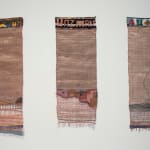


Consuelo Jimenez Underwood American, b. 1949
Woody, My Dad and Me, 2018
Woven wire, linen, metallic and cotton thread
49 x 17 each (49 x 51 in)
124.5 x 43.2 cm
124.5 x 43.2 cm
Further images
Together, these rebozos form the phrase “Thi$ land waz made 4 u + me”, a popular lyric from Woody Guthrie’s “This Land is Your Land.” The far left piece includes...
Together, these rebozos form the phrase “Thi$ land waz made 4 u + me”, a popular lyric from Woody Guthrie’s “This Land is Your Land.” The far left piece includes an outline of the West Coast and the far right piece features the East Coast of the United States. Guthrie, who identified as a “commonist, not a communist” and an educator rather than an entertainer, has long been a hero to Jimenez Underwood. She says of her own work: “I think of my work as woven corridos. Songs about political strife and physical strife, and that’s what my work is about.” The artist’s Huichol father introduced her to weaving, and she follows the Huichol tradition of weaving narratives into her work. During her childhood, her father was also undocumented and deported on multiple occasions.
"Consuelo Jimenez Underwood's weaving has its source in the experiences of her family, particularly her father, an undocumented worker who would often weave hidden in the garage during times of unemployment. She spent many hours with her father as he wove, and she describes these times as the happiest of her childhood amid twelve siblings." Amalia Mesa-Bains, "A Tear in the Curtain", Consuelo Jimenez Underwood: Art, Weavings, Vision, Duke University Press, 2022
"Consuelo Jimenez Underwood's weaving has its source in the experiences of her family, particularly her father, an undocumented worker who would often weave hidden in the garage during times of unemployment. She spent many hours with her father as he wove, and she describes these times as the happiest of her childhood amid twelve siblings." Amalia Mesa-Bains, "A Tear in the Curtain", Consuelo Jimenez Underwood: Art, Weavings, Vision, Duke University Press, 2022
Exhibitions
Consuelo Jimenez Underwood: Threads from Border-landia, Ruiz-Healy Art, New York, NY, 2022Consuelo J. Underwood: Thread Songs from the Borderlands, 108 Contemporary, Tulsa, OK, 2018
Literature
Laura E. Perez and Ann Marie Leimer, eds., Consuelo Jimenez Underwood: Art, Weaving, Vision, Durham, North Carolina: Duke University Press, 2022, between 160-161 (illustrated)



